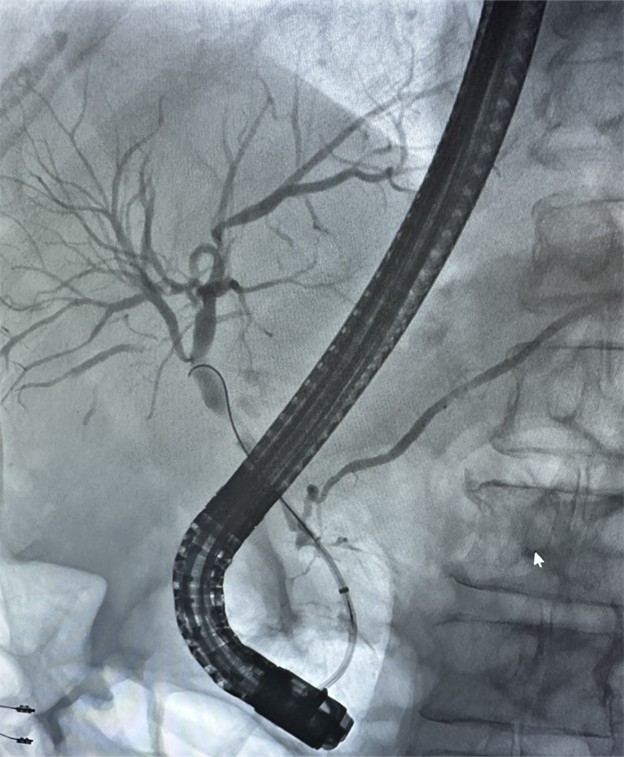Sunday Poster Session
Category: Biliary/Pancreas
P0228 - A Rare Case of Gallbladder Cancer Presenting as a Sister Mary Joseph Nodule
Sunday, October 26, 2025
3:30 PM - 7:00 PM PDT
Location: Exhibit Hall

Fares Kasem, DO
University of Louisville
Louisville, KY
Presenting Author(s)
Ethan R. Steele, DO1, Fares Kasem, DO2, Nanlong Liu, MD2
1University of Louisville School of Medicine, Louisville, KY; 2University of Louisville, Louisville, KY
Introduction: Sister Mary Joseph Nodule is an eponym for the rare physical exam finding of an umbilical tumor signifying an advanced stage of malignancy of abdominopelvic origin. This case highlights the rare skin finding as the first manifestation of an unusual presentation of gallbladder cancer.
Case Description/
Methods: A 70-year-old female presented to the hospital with an erythematous, tender umbilical lesion that had been worsening over multiple months. Physical exam showed an erythematous nodule over the umbilical area measuring 4x2 centimeters with induration and no drainage. A punch biopsy was performed. CT abdomen/pelvis (CTAP) showed significant gallbladder thickening and periportal edema concerning for cholangitis or gallbladder malignancy. MRCP showed diffuse gallbladder wall thickening and enhancement without a definite focal mass. ERCP was performed and it showed an anomalous pancreaticobiliary junction, with the pancreatic duct (PD) inserting into the mid-distal common bile duct. Despite a full 4 mm biliary sphincterotomy, the PD was seen repeatedly with any contrast injection. Same session Spyglass was performed showing no evidence of intra-luminal cholangiocarcinoma at the hilum. Dermatological punch biopsy performed earlier revealed adenocarcinoma of upper GI or pancreaticobiliary origin.
Discussion: This case highlights an unusual presentation of gallbladder cancer. Injected contrast in the mid common bile duct revealed anomalous pancreaticobiliary anatomy, with the PD inserting into the distal third of the bile duct. This likely increased the risk of carcinogenesis due to increased reflux of pancreatic enzymes into the bile duct and gallbladder. Liver function tests were only mildly elevated on initial presentation (AST 23, ALT 34, ALP 146, and total bilirubin 0.3); therefore, they cannot be considered an adequate marker of disease progression. The patient's only other sign of malignancy was weight loss (BMI 16.5), which is a common presenting sign seen in many malignancies.
Pancreaticobiliary malignancies tend to present in advanced stages due to an overall lack of adequate screening available today. Sister Mary Joseph Nodule is a rare finding that can be associated with such malignancies. As seen in our patient, punch biopsy of the lesion is the first step to determine cancer origin. These lesions can be mistaken for cellulitis or other benign forms of dermatitis. One must have a high index of suspicion to look for an underlying malignancy when periumbilical lesions are present.

Figure: Cholangiogram showing anomalous pancreaticobiliary junction

Figure: Patient's umbilical lesion present on initial evaluation
Disclosures:
Ethan Steele indicated no relevant financial relationships.
Fares Kasem indicated no relevant financial relationships.
Nanlong Liu indicated no relevant financial relationships.
Ethan R. Steele, DO1, Fares Kasem, DO2, Nanlong Liu, MD2. P0228 - A Rare Case of Gallbladder Cancer Presenting as a Sister Mary Joseph Nodule, ACG 2025 Annual Scientific Meeting Abstracts. Phoenix, AZ: American College of Gastroenterology.
1University of Louisville School of Medicine, Louisville, KY; 2University of Louisville, Louisville, KY
Introduction: Sister Mary Joseph Nodule is an eponym for the rare physical exam finding of an umbilical tumor signifying an advanced stage of malignancy of abdominopelvic origin. This case highlights the rare skin finding as the first manifestation of an unusual presentation of gallbladder cancer.
Case Description/
Methods: A 70-year-old female presented to the hospital with an erythematous, tender umbilical lesion that had been worsening over multiple months. Physical exam showed an erythematous nodule over the umbilical area measuring 4x2 centimeters with induration and no drainage. A punch biopsy was performed. CT abdomen/pelvis (CTAP) showed significant gallbladder thickening and periportal edema concerning for cholangitis or gallbladder malignancy. MRCP showed diffuse gallbladder wall thickening and enhancement without a definite focal mass. ERCP was performed and it showed an anomalous pancreaticobiliary junction, with the pancreatic duct (PD) inserting into the mid-distal common bile duct. Despite a full 4 mm biliary sphincterotomy, the PD was seen repeatedly with any contrast injection. Same session Spyglass was performed showing no evidence of intra-luminal cholangiocarcinoma at the hilum. Dermatological punch biopsy performed earlier revealed adenocarcinoma of upper GI or pancreaticobiliary origin.
Discussion: This case highlights an unusual presentation of gallbladder cancer. Injected contrast in the mid common bile duct revealed anomalous pancreaticobiliary anatomy, with the PD inserting into the distal third of the bile duct. This likely increased the risk of carcinogenesis due to increased reflux of pancreatic enzymes into the bile duct and gallbladder. Liver function tests were only mildly elevated on initial presentation (AST 23, ALT 34, ALP 146, and total bilirubin 0.3); therefore, they cannot be considered an adequate marker of disease progression. The patient's only other sign of malignancy was weight loss (BMI 16.5), which is a common presenting sign seen in many malignancies.
Pancreaticobiliary malignancies tend to present in advanced stages due to an overall lack of adequate screening available today. Sister Mary Joseph Nodule is a rare finding that can be associated with such malignancies. As seen in our patient, punch biopsy of the lesion is the first step to determine cancer origin. These lesions can be mistaken for cellulitis or other benign forms of dermatitis. One must have a high index of suspicion to look for an underlying malignancy when periumbilical lesions are present.

Figure: Cholangiogram showing anomalous pancreaticobiliary junction

Figure: Patient's umbilical lesion present on initial evaluation
Disclosures:
Ethan Steele indicated no relevant financial relationships.
Fares Kasem indicated no relevant financial relationships.
Nanlong Liu indicated no relevant financial relationships.
Ethan R. Steele, DO1, Fares Kasem, DO2, Nanlong Liu, MD2. P0228 - A Rare Case of Gallbladder Cancer Presenting as a Sister Mary Joseph Nodule, ACG 2025 Annual Scientific Meeting Abstracts. Phoenix, AZ: American College of Gastroenterology.
